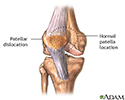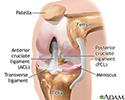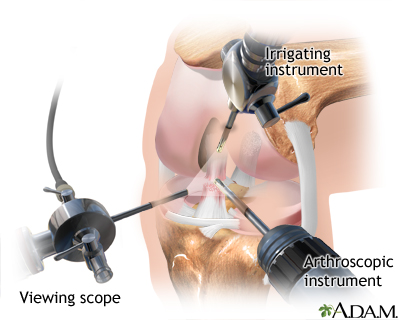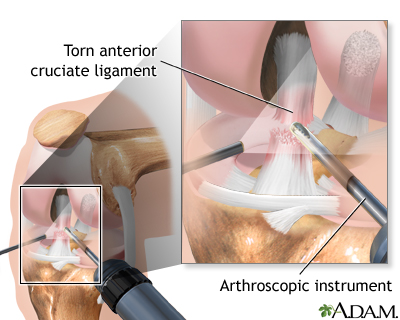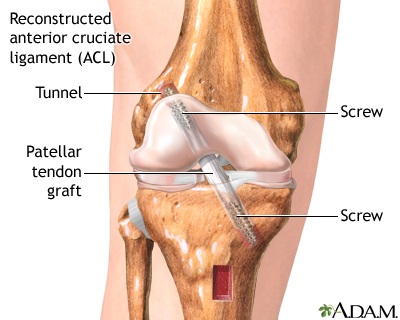Kneecap dislocation
Dislocation - kneecap; Patellar dislocation or instability
Kneecap dislocation occurs when the triangle-shaped bone covering the knee (patella) moves or slides out of place. The problem usually occurs toward the outside of the leg.
Causes
Kneecap (patella) dislocation is often seen in women. It usually occurs after a sudden change in direction when your leg is planted. This puts your kneecap under stress.
Dislocation may also occur as result of direct trauma. When the kneecap is dislocated, it can slip sideways to the outside of the knee.
Symptoms
Symptoms of kneecap dislocation include:
- Knee appears to be deformed
- Knee is bent and cannot be straightened out
- Kneecap (patella) dislocates to the outside of the knee
-
Knee pain
and tenderness
Knee pain
Knee pain is a common symptom in people of all ages. It may start suddenly, often after an injury or exercise. Knee pain also may begin as a mild d...
 ImageRead Article Now Book Mark Article
ImageRead Article Now Book Mark Article -
Knee swelling
Knee swelling
Joint swelling is the buildup of fluid in the soft tissue surrounding the joint.
 ImageRead Article Now Book Mark Article
ImageRead Article Now Book Mark Article - "Sloppy" kneecap -- you can move the kneecap too much from right to left (hypermobile patella)
The first few times this occurs, you will feel pain and be unable to walk. However, if dislocations continue to occur and are untreated, you may feel less pain and have less immediate disability. This is not a reason to avoid treatment. Kneecap dislocation damages your knee joint.
First Aid
If you can, straighten out your knee. If it is stuck and painful to move, stabilize (splint) the knee and get medical attention.
Your health care provider will examine your knee. This may confirm that the kneecap is dislocated.
A knee x-ray and, sometimes, MRIs should be done to make sure that the dislocation did not cause a broken bone or cartilage damage. If tests show that you have no damage, your knee will be placed into an immobilizer or cast to prevent you from moving it. you will need to wear this for several weeks (usually about 3 weeks).
Knee x-ray
This test is an x-ray of a knee, shoulder, hip, wrist, ankle, or other joint.
After this time, physical therapy can help build back your muscle strength and improve the knee's range of motion.
If there is damage to the bone and cartilage, or if the kneecap continues to be unstable, you may need surgery to stabilize the kneecap. This may be done using arthroscopic or open surgery.
Arthroscopic
Knee arthroscopy is surgery that uses a tiny camera to look inside your knee. Small cuts are made to insert the camera and small surgical tools into...

When to Contact a Medical Professional
Call your health care provider if you injure your knee and have symptoms of dislocation.
Call your health care provider if you are being treated for a dislocated knee and you notice:
- Increased instability in your knee
-
Pain or
swelling
return after they went away
Swelling
Swelling is the enlargement of organs, skin, or other body parts. It is caused by a buildup of fluid in the tissues. The extra fluid can lead to a ...
 ImageRead Article Now Book Mark Article
ImageRead Article Now Book Mark Article - Your injury does not appear to be getting better with time
Also call if you re-injure your knee.
Prevention
Use proper techniques when exercising or playing sports. Keep your knee strong and flexible.
Some cases of knee dislocation may not be preventable, especially if physical factors make you more likely to dislocate your knee.
References
Mascioli AA. Acute dislocations. In: Canale ST, Beaty JH, eds. Campbell's Operative Orthopaedics. 12th ed. Philadelphia, PA: Elsevier Mosby; 2013:chap 60.
Tan EW, Cosgarea AJ. Patellar instability. In: Miller MD, Thompson SR, eds.
DeLee and Drez's Orthopaedic Sports Medicine
. 4th ed. Philadelphia, PA: Elsevier Saunders; 2015:chap 104.
-
Arthroscopy - illustration
Knee arthroscopy is surgery that is done to check for problems, using a tiny camera to see inside your knee. Other medical instruments may also be inserted to repair your knee.
Arthroscopy
illustration
-
Patellar dislocation - illustration
Dislocation usually occurs as a result of sudden direction changes while running and the knee is under stress or it may occur as a direct result of injury.
Patellar dislocation
illustration
-
Knee arthroscopy - series
Presentation
-
Arthroscopy - illustration
Knee arthroscopy is surgery that is done to check for problems, using a tiny camera to see inside your knee. Other medical instruments may also be inserted to repair your knee.
Arthroscopy
illustration
-
Patellar dislocation - illustration
Dislocation usually occurs as a result of sudden direction changes while running and the knee is under stress or it may occur as a direct result of injury.
Patellar dislocation
illustration
-
Knee arthroscopy - series
Presentation
Review Date: 1/12/2016
Reviewed By: Dennis Ogiela, MD, Orthopedic Surgeon, Danbury Hospital, Danbury, CT. Review provided by VeriMed Healthcare Network. Also reviewed by David Zieve, MD, MHA, Isla Ogilvie, PhD, and the A.D.A.M. Editorial team.


